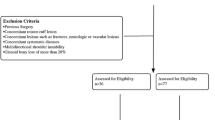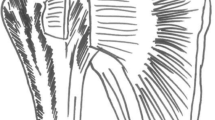Abstract
Purpose
The use of a low anteroinferior (5:30 o’clock) portal for arthroscopic shoulder stabilization allows an anatomical refixation of the capsulolabral complex. This anteroinferior portal, however, penetrates the inferior subscapularis (SSC), which is criticized. Therefore, the aim of the study was to evaluate the functional and structural properties of the SSC in patients with anteroinferior shoulder stabilization. The hypothesis was that it does not harm the SSC by demonstrating full muscular function and imaging-based normal structure at a long-term follow-up.
Methods
Twenty patients were examined (14 males and six females; mean age 37.0 years) retrospectively after a mean follow-up of 9.6 years. At final follow-up, clinical examination and clinical scores (ASES, Constant–Murley, WOSI, and Rowe score) were documented. Additionally, SSC strength was evaluated with a custom-made electronic force measurement plate. All patients underwent bilateral magnetic resonance imaging to assess structural integrity and fatty infiltration (grading according to Fuchs et al.) of the SSC. Furthermore, vertical and transversal (superior and inferior) diameters of the muscle and the muscle area in a parasagittal plane were measured.
Results
Clinical scores revealed good-to-excellent long-term results (ASES 92 points, Constant–Murley 82 points, WOSI 85 %, and Rowe 84 points). Force measurement in comparison with the contralateral side showed no significant (p > 0.05) differences for the ‘belly-press’ test (ipsilateral 102 N vs. contralateral 101 N) and the ‘lift-off’ test (73 vs. 69 N). There were also no significant differences between the mean diameters and the areas of the SSC muscle belly (vertical diameter ipsilateral 92 mm vs. contralateral 94 mm; superior transversal 28 vs. 29 mm; inferior transversal 34 vs. 34 mm; area 2336 vs. 2526 mm2).
Conclusion
Arthroscopic labral repair with a low anteroinferior portal demonstrates no signs of structural and functional impairment of the SSC after 9.6 year follow-up. For clinical relevance, the lower part of the SSC can be penetrated for an optimal anchor placement in shoulder instabilities or Bankart fractures without concerns of a negative long-term effect on the SSC.
Level of evidence
Case series, Level IV.



Similar content being viewed by others
References
Barth JR, Burkhart SS, De Beer JF (2006) The bear-hug test: a new and sensitive test for diagnosing a subscapularis tear. Arthroscopy 22(10):1076–1084
Bartl C, Salzmann GM, Seppel G, Eichhorn S, Holzapfel K, Wortler K, Imhoff AB (2011) Subscapularis function and structural integrity after arthroscopic repair of isolated subscapularis tears. Am J Sports Med 39(6):1255–1262
Bartl C, Schumann K, Paul J, Vogt S, Imhoff AB (2011) Arthroscopic capsulolabral revision repair for recurrent anterior shoulder instability. Am J Sports Med 39(3):511–518
Boileau P, Villalba M, Hery JY, Balg F, Ahrens P, Neyton L (2006) Risk factors for recurrence of shoulder instability after arthroscopic Bankart repair. J Bone Joint Surg Am 88(8):1755–1763
Constant CR, Murley AH (1987) A clinical method of functional assessment of the shoulder. Clin Orthop Relat Res 214:160–164
De Simoni C, Burkart A, Imhoff AB (2000) A new inferior (5.30 o’clock) portal for arthroscopic repair of Bankart lesions. Arthroskopie 13(5):217–219
Fuchs B, Weishaupt D, Zanetti M, Hodler J, Gerber C (1999) Fatty degeneration of the muscles of the rotator cuff: assessment by computed tomography versus magnetic resonance imaging. J Shoulder Elbow Surg 8(6):599–605
Gartsman GM, Roddey TS, Hammerman SM (2000) Arthroscopic treatment of anterior-inferior glenohumeral instability. Two to five-year follow-up. J Bone Joint Surg Am 82-A(7):991–1003
Greis PE, Dean M, Hawkins RJ (1996) Subscapularis tendon disruption after Bankart reconstruction for anterior instability. J Shoulder Elbow Surg 5(3):219–222
Hertel R, Ballmer FT, Lombert SM, Gerber C (1996) Lag signs in the diagnosis of rotator cuff rupture. J Shoulder Elbow Surg 5(4):307–313
Imhoff AB, Ansah P, Tischer T, Reiter C, Bartl C, Hench M, Spang JT, Vogt S (2010) Arthroscopic repair of anterior-inferior glenohumeral instability using a portal at the 5:30-o’clock position: analysis of the effects of age, fixation method, and concomitant shoulder injury on surgical outcomes. Am J Sports Med 38(9):1795–1803
Juul-Kristensen B, Bojsen-Moller F, Finsen L, Eriksson J, Johansson G, Stahlberg F, Ekdahl C (2000) Muscle sizes and moment arms of rotator cuff muscles determined by magnetic resonance imaging. Cells Tissues Organs 167(2–3):214–222
Kirkley A, Griffin S, McLintock H, Ng L (1998) The development and evaluation of a disease-specific quality of life measurement tool for shoulder instability. The Western Ontario Shoulder Instability Index (WOSI). Am J Sports Med 26(6):764–772
Lenters TR, Franta AK, Wolf FM, Leopold SS, Matsen FA 3rd (2007) Arthroscopic compared with open repairs for recurrent anterior shoulder instability. A systematic review and meta-analysis of the literature. J Bone Joint Surg Am 89(2):244–254
Mauro CS, Voos JE, Hammoud S, Altchek DW (2011) Failed anterior shoulder stabilization. J Shoulder Elbow Surg 20(8):1340–1350
Maynou C, Cassagnaud X, Mestdagh H (2005) Function of subscapularis after surgical treatment for recurrent instability of the shoulder using a bone-block procedure. J Bone Joint Surg Br 87(8):1096–1101
Meyer M, Graveleau N, Hardy P, Landreau P (2007) Anatomic risks of shoulder arthroscopy portals: anatomic cadaveric study of 12 portals. Arthroscopy 23(5):529–536
Picard F, Saragaglia D, Montbarbon E, Tourne Y, Thony F, Charbel A (1998) Anatomo-clinical consequences of the vertical sectioning of the subscapular muscle in Latarjet intervention. Rev Chir Orthop Reparatrice Appar Mot 84(3):217–223
Rhee YG, Ha JH, Cho NS (2006) Anterior shoulder stabilization in collision athletes: arthroscopic versus open Bankart repair. Am J Sports Med 34(6):979–985
Rhee YG, Lim CT, Cho NS (2007) Muscle strength after anterior shoulder stabilization: arthroscopic versus open Bankart repair. Am J Sports Med 35(11):1859–1864
Richards RR, An KN, Bigliani LU, Friedman RJ, Gartsman GM, Gristina AG, Iannotti JP, Mow VC, Sidles JA, Zuckerman JD (1994) A standardized method for the assessment of shoulder function. J Shoulder Elbow Surg 3(6):347–352
Rowe CR, Patel D, Southmayd WW (1978) The Bankart procedure: a long-term end-result study. J Bone Joint Surg Am 60(1):1–16
Scheibel M, Magosch P, Pritsch M, Lichtenberg S, Habermeyer P (2005) The belly-off sign: a new clinical diagnostic sign for subscapularis lesions. Arthroscopy 21(10):1229–1235
Scheibel M, Nikulka C, Dick A, Schroeder RJ, Popp AG, Haas NP (2007) Structural integrity and clinical function of the subscapularis musculotendinous unit after arthroscopic and open shoulder stabilization. Am J Sports Med 35(7):1153–1161
Schröder RJ, Scheibel M, Tsynman A, Magosch P, Habermeyer P (2006) Magnetic resonance analysis of the subscapularis muscle after open anterior shoulder stabilization. Rofo 178(7):706–712
Tauber M, Resch H, Forstner R, Raffl M, Schauer J (2004) Reasons for failure after surgical repair of anterior shoulder instability. J Shoulder Elbow Surg 13(3):279–285
Tischer T, Vogt S, Imhoff AB (2007) Arthroscopic stabilization of the shoulder with suture anchors with special reference to the deep anterior-inferior portal (5.30 o’clock). Oper Orthop Traumatol 19(2):133–154
Voos JE, Livermore RW, Feeley BT, Altchek DW, Williams RJ, Warren RF, Cordasco FA, Allen AA (2010) Prospective evaluation of arthroscopic Bankart repairs for anterior instability. Am J Sports Med 38(2):302–307
Yoon JP, Chung SW, Kim SH, Oh JH (2013) Diagnostic value of four clinical tests for the evaluation of subscapularis integrity. J Shoulder Elbow Surg 22(9):1186–1192
Acknowledgments
The authors thank Christoph Bartl (Department of Traumatology, Hand and Reconstructive Surgery, University of Ulm, Ulm, Germany) and Stefan Eichhorn (Department of Biomechanics, Technische Universität München, Munich, Germany) for their help with the electronic force measurement plate.
Conflict of interest
The authors state that there is no conflict of interest.
Author information
Authors and Affiliations
Corresponding author
Additional information
Stefan Buchmann and Peter U. Brucker have contributed equally to this work.
Rights and permissions
About this article
Cite this article
Buchmann, S., Brucker, P.U., Beitzel, K. et al. Long-term effects on subscapularis integrity and function following arthroscopic shoulder stabilization with a low anteroinferior (5:30 o’clock) portal. Knee Surg Sports Traumatol Arthrosc 24, 422–429 (2016). https://doi.org/10.1007/s00167-015-3545-4
Received:
Accepted:
Published:
Issue Date:
DOI: https://doi.org/10.1007/s00167-015-3545-4




